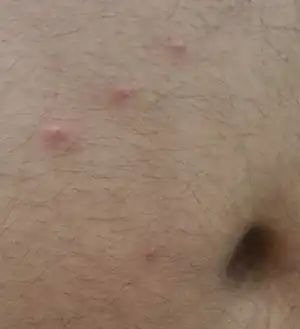Breakfast, lunch, and dinner sign
| Breakfast, lunch, dinner sign | |
|---|---|
| Other names: Breakfast, lunch, and supper sign[1] | |
 | |
| Breakfast, lunch, dinner sign | |
| Specialty | Dermatology |
| Symptoms | Small bumps together[2] |
| Complications | Infection[3] |
| Causes | Insect bites[2] |
| Diagnostic method | Appearance[3] |
| Prevention | Environment controls[3] |
| Medication | Antihistamine, steroid cream[3] |
| Prognosis | Good[3] |
| Frequency | Common[3] |
Breakfast, lunch, and dinner sign refers to a pattern of small bumps of the skin seen following insect bites.[2] Generally three to five appear close together, in a cluster or line, and at the same time.[1][3] Each bump is mostly smaller than 1cm, appear pinkish, and may itch.[3] The sign is typically seen on exposed parts of the body such as the face, neck, arms, or legs.[3]
The cause is the bites of insects such as fleas and bed bugs.[3] Unable to fly, fleas and bed bugs generally jump or walk to bite, causing the bite marks to appear in a line.[4][5] An enzyme in the saliva of the insect may cause a local allergic reaction, resulting in a larger bump that is itchy.[3] Diagnosis is by its appearance.[3]
Treatment includes antihistamines to reduce itch, and applying a steroid cream to reduce redness and swelling.[3] Prevention lies in insect control within the environment.[3] It is common.[3]
Signs and symptoms
See also
References
- 1 2 Madke, B; Nayak, C (September 2012). "Eponymous signs in dermatology". Indian dermatology online journal. 3 (3): 159–65. doi:10.4103/2229-5178.101810. PMID 23189246.
- 1 2 3 Bolognia, Jean L.; Schaffer, Julie V.; Duncan, Karynne O.; Ko, Christine (2021). "55. Disorders of hyperpigmentation". Dermatology Essentials (2nd ed.). Elsevier. p. 522. ISBN 978-0-323-70971-2. Archived from the original on 2023-08-11. Retrieved 2023-08-09.
- 1 2 3 4 5 6 7 8 9 10 11 12 13 14 15 Peres, Gabriel; Yugar, Lara Buonalumi Tacito; Haddad Junior, Vidal (October 2018). "Breakfast, lunch, and dinner sign: a hallmark of flea and bedbug bites". Anais Brasileiros de Dermatologia. 93 (5): 759–760. doi:10.1590/abd1806-4841.20187384. PMID 30156636. Archived from the original on 2023-05-15. Retrieved 2023-07-31.
- ↑ Paller, Amy S.; Mancini, Anthony J. (2020). "18. Infestations, bites, and stings". Paller and Mancini - Hurwitz Clinical Pediatric Dermatology: A Textbook of Skin Disorders of Childhood and Adolescence (6th ed.). St. Louis, Missouri: Elsevier. p. 512. ISBN 978-0-323-54988-2. Archived from the original on 2023-08-11. Retrieved 2023-08-10.
- ↑ Eichenfield, Lawrence F.; Frieden, Ilona J.; Mathes, Erin; Zaenglein, Andrea (25 August 2014). Neonatal and Infant Dermatology. Elsevier Health Sciences. p. 212. ISBN 978-1-4557-2639-4. Archived from the original on 14 August 2023. Retrieved 12 August 2023.
.jpg.webp)